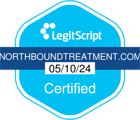Cocaine is highly addictive due to the rush of euphoria it provides. This high is short-lived, sometimes only five or ten minutes, which causes people to continue with additional doses at greater frequency to continue feeling the pleasure as much as possible. This type of behavior develops a tolerance to the stimulant drug. Eventually, a person will require using cocaine more often to achieve the same results as when they first started.
Tolerance leads to cocaine dependency and eventually, addiction. Once a person comes down from their high, the long-term effects are often an abrupt contrast to the pleasurable feelings of before. There are rarely physical side effects; most of them are mental and psychological because of how much it affects the brain. You may appear happy or excited to an extreme level at first, but often cocaine addiction symptoms make a person feel aggressive, depressed, or paranoid once the high has worn off. That’s why addiction treatment is designed to help those who experience drug abuse in this way – rehab centers use programs that help get to the root of the addiction and treat it at the source in order to achieve prolonged recovery.
Since it’s a stimulant, using it makes you feel unstoppable and in a fast-paced motion. It causes you to talk faster, become restless, and experience a rapid heart rate and/or blood pressure. Dilated pupils, strong sensitivity to light, and feelings of disorientation or hallucinations are symptomatic of cocaine addiction.
A frequency of nosebleeds or nasal septum pain are physical symptoms of cocaine addiction use when snorting it. Constant sniffling or a runny nose may be a sign as well when combined with some of the behavioral changes mentioned above. It can also cause you to lose your sense of smell.
For those injecting cocaine, bruising or track marks become visible. Used needles and other drug paraphernalia are also obvious signs of cocaine use.
The high from cocaine is strong, but not long-lasting. When snorted, it may last up to 30 minutes, when injected, maybe 10. Frequent use occurs to achieve the high for a longer stretch of time. This may lead to cocaine overdose, which is not an uncommon symptom of cocaine addiction. According to the National Institute on Drug Abuse, more than 67,300 Americans died from drug-involved overdose in 2018. Cocaine is responsible for the highest number of overdose deaths behind synthetic narcotics (mainly fentanyl) and prescription opioids.
When a person experiences cocaine addiction, the drug has already changed the makeup of the brain. It means the brain thinks it needs cocaine in order to function. As a result, when you are no longer using it, withdrawal symptoms set in, which can be equally painful and uncomfortable. Although you may be able to refrain from use for a few hours, the cravings likely will become too strong and you’ll do anything to make them go away.
Withdrawal Symptoms Point to Cocaine Addiction
When addiction is part of the picture, it’s difficult to fight off strong cravings and manage the intensity of withdrawal symptoms, which settle in within a few hours after the last dose. After the high has worn off, a person may immediately turn aggressive or angry.
For loved ones who are concerned about their friend or family member’s drug use, these constant mood swings are indicative that something may be wrong, whether it’s the beginning of cocaine use or addiction. Other changes in mood include:
- Hyper-agitation
- Lack of inhibitions
- Poor decision-making
- Extreme, abnormal enthusiasm
- Body tics or shakiness
- Inability to focus or concentrate
Withdrawal symptoms can make you feel confused and detached. It may lead to anxiety, depression, insomnia, or a combination of all. The depressive feelings that occur when taking a stimulant like cocaine are harsh on the body and mind as it tries to regulate and balance itself.
You may try to cocaine detox at home, but this often doesn’t carry long-term success. It’s best to seek the care of a medically managed detox program. It provides a safe and secure space as you go through withdrawal. With constant medical supervision and emotional support, it provides a sense of stability as you try to make your way through the process.
There’s a far greater likelihood of long-term sobriety if you turn to the assistance of others through a temporary, but impactful treatment program. For many, the pain and suffering that comes with withdrawal symptoms is too much to bear alone. Therefore, it’s common for people to relapse and continue abusing cocaine, often in greater amounts than before.
Other Negative Effects of Cocaine Addiction
In addition to emotional and psychological cocaine addiction symptoms, there is usually occurrences of problem behavior as a result as well. Those who are addicted to cocaine often have problems at work, at home, and sometimes with the law. It can make a person become withdrawn from close friends and family members if they’re trying to hide their use. It could lead to other dangerous or violent behavior due to the after-effects of the high.
Abusing cocaine limits the ability to make rational decisions. When high, this sense of freedom may feel good, but in reality, it’s destructive to the user and those around them. They may be unaware of how their behavior is affecting others until something specific happens. This may be getting fired from a job, ending a relationship, or getting arrested. None of these are ideal situations and can lead to long-term results which can change a person’s life forever.
Cocaine is dangerous on any level and only leads to problems. Rather than trying to control use or addiction on your own, turn to those who are trained to provide counseling and care to see you through to sobriety. The effects of cocaine abuse on the body and mind is cumulative, which means it’s only a matter of time before the addiction catches up to you.
Addiction seeps into every part of life and slowly destroys everything in its path. This is not a sustainable way to live. Give yourself a chance for a more promising future turning to others for help and considering the options that are available.
Finding Treatment That Works for You
A focused plan of attack that involves customized treatment is the best way to move forward. The first step is entering a detox program that is medically supervised by doctors and therapists who can monitor your physical and mental health day and night.
Detox is tough to handle and can be unpredictable. The support of others can make the process as comfortable as possible in a sturdy environment, which will allow you to heal without being able to give into temptation. The period of withdrawal symptoms lasts for several days and is necessary before starting any kind of behavioral treatment. The body must be rid of the drug before moving forward.
After detox, you can step onto the path to healing. The first phase involves a residential care program. This is the time to explore your addiction further and see what’s at the root of the issue. Identifying negative influences and triggers is important to your progress. You’ll learn how to treat cocaine addiction by coping in the future when you are faced with temptation.
Additionally, residential rehab gives you a calm space to concentrate fully on your treatment without the interruption of daily life or the toxic environment you’re coming from. It includes individual and group counseling, exercise, and meditation as part of a holistic form of care. It requires treating all parts of the mind and body in order to fully heal from the inside out.
Residential rehab is usually recommended for a 90-day period, although this varies depending on the person’s specific situation and goals. The cocaine detox timeline is individualized for each person’s pace, which may require an extended stay past the first three months. Once you graduate from the residential program, you advance to intensive outpatient treatment.
As a continuation of residential rehab, outpatient care continues to build your independence and confidence through learned strategies and coping mechanisms. This allows for schedule flexibility and doesn’t require a stay at the treatment center. Once you have secured a sober and safe living space, the program requires at least 12 hours a week, which you can fit to meet your schedule.
During this time, there’s the opportunity to participate in specialized programs like Northbound’s CareerBound®, CollegeBound®, or other programs. There are specific programs focused on reuniting families who have been affected by addiction. Everyone has a goal of what they’d like to receive during treatment. It may be securing a job, enrolling in school, or reconnecting with people they’ve lost touch with due to addiction.
Although this level of treatment immediately follows rehab, it is also favored by anyone who has previously gone through the detox and residential rehab treatment before, but needs accountability or extra attention to prevent relapse from occurring. Addiction is a disease for which there is no cure. Recovery requires a constant management of symptoms.
With a team of certified and trained specialists and medical professionals, you’ll create a plan that works for you based on what you want to achieve during rehab and as you re-enter real life. The structured format provides a foundation which you can rely on and guide you back into healthier habits.
This will prove beneficial as you continue to build a sober way of living and learning the tools and techniques to carry without once treatment is complete. Receive the dedicated care you need to overcome the pain of cocaine addiction. There is always help available to you.
Sources:
- “Drug Addiction (Substance Use Disorder) – Symptoms and Causes – Mayo Clinic.” Mayoclinic.org. N.p., 26 Oct. 2017., https://www.mayoclinic.org/diseases-conditions/drug-addiction/symptoms-causes/syc-20365112
- “Overdose Death Rates | National Institute on Drug Abuse.” Drugabuse.gov. N.p., 10 Mar. 2020., https://www.drugabuse.gov/related-topics/trends-statistics/overdose-death-rates











